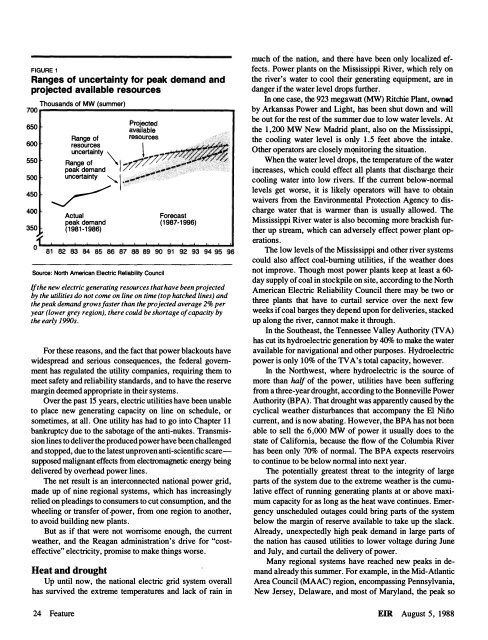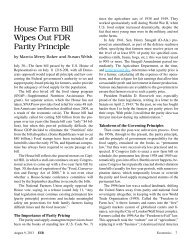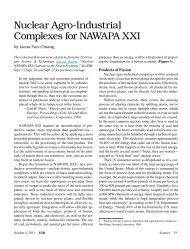View Full Issue - Executive Intelligence Review
View Full Issue - Executive Intelligence Review
View Full Issue - Executive Intelligence Review
Create successful ePaper yourself
Turn your PDF publications into a flip-book with our unique Google optimized e-Paper software.
FIGURE 1<br />
Ranges of uncertainty for peak demand and<br />
projected available resources<br />
Thousands of MW (summer)<br />
700 r---<br />
650<br />
600<br />
550<br />
500<br />
450<br />
400<br />
350<br />
Range of<br />
resources<br />
uncertainty \<br />
Range of<br />
peak demand<br />
uncertainty ""<br />
�<br />
Actual<br />
peak demand<br />
(1981-1986)<br />
Source: North American Electric Reliability Council<br />
I<br />
I<br />
Forecast<br />
(1987-1996)<br />
If the new electric generating resources that have been projected<br />
by the utilities do not come on line on time (top hatched lines) and<br />
the peak demand grows faster than the projected average 2% per<br />
year (lower grey region), there could be shortage of capacity by<br />
the early 1990s.<br />
For these reasons, and the fact that power blackouts have<br />
widespread and serious consequences, the federal govern<br />
ment has regulated the utility companies, requiring them to<br />
meet safety and reliability standards, and to have the reserve<br />
margin deemed appropriate in their systems.<br />
Over the past 15 years, electric utilities have been unable<br />
to place new generating capacity on line on schedule, or<br />
sometimes, at all. One utility has had to go into Chapter 11<br />
bankruptcy due to the sabotage of the anti-nukes. Transmis<br />
sion lines to deliver the produced power have been challenged<br />
and stopped, due to the latest unproven anti-scientific scare<br />
supposed malignant effects from electromagnetic energy being<br />
delivered by overhead power lines.<br />
The net result is an interconnected national power grid,<br />
made up of nine regional systems, which has increasingly<br />
relied on pleadings to consumers to cut consumption, and the<br />
wheeling or transfer of power , from one region to another,<br />
to avoid building new plants.<br />
But as if that were not worrisome enough, the current<br />
weather, and the Reagan administration's drive for "cost<br />
effective" electricity, promise to make things worse.<br />
Heat and drought<br />
Up until now, the national electric grid system overall<br />
has survived the extreme temperatures and lack of rain in<br />
24 Feature<br />
-- -- -- -- -- -- -- -- -- -- -- -- -- -- -- --�<br />
much of the nation, and there have been only localized ef<br />
fects. Power plants on the Mississippi River, which rely on<br />
the river's water to cool their generating equipment, are in<br />
danger if the water level drops further.<br />
In one case, the 923 megawatt (MW) Ritchie Plant, owned<br />
by Arkansas Power and Light, has been shut down and will<br />
be out for the rest of the summer due to low water levels. At<br />
the 1,200 MW New Madrid plant, also on the Mississippi,<br />
the cooling water level is only 1.5 feet above the intake.<br />
Other operators are closely m()nitoring the situation.<br />
When the water level drops, the temperature of the water<br />
increases, which could effect all plants that discharge their<br />
cooling water into low rivers. If the current below-normal<br />
levels get worse, it is likely operators will have to obtain<br />
waivers from the Environmental Protection Agency to dis<br />
charge water that is warmer than is usually allowed. The<br />
Mississippi River water is also becoming more brackish fur<br />
ther up stream, which can adversely effect power plant op<br />
erations.<br />
The low levels of the Mississippi and other river systems<br />
could also affect coal-burning utilities, if the weather does<br />
not improve. Though most power plants keep at least a 60-<br />
day supply of coal in stockpile on site, according to the North<br />
American Electric Reliability Council there may be two or<br />
three plants that have to curtail service over the next few<br />
weeks if coal barges they depend upon for deliveries, stacked<br />
up along the river, cannot make it through.<br />
In the Southeast, the Tennessee Valley Authority (TVA)<br />
has cut its hydroelectric generation by 40% to make the water<br />
available for navigational and other purposes. lJydroelectric<br />
power is only 10% of the TVA's total capacity, however.<br />
In the Northwest, where hydroelectric is the source of<br />
more than half of the power, utilities have been suffering<br />
from a three-year drought, according to the Bonneville Power<br />
Authority (BPA). That drought was apparently caused by the<br />
cyclical weather disturbances that accompany the El Nino<br />
current, and is now abating. However, the BPA has not been<br />
able to sell the (),OOO MW of power it usually does to the<br />
state of California, because the flow of the Columbia River<br />
has been only 70% of normal. The BPA expects reservoirs<br />
to continue to be below normal into next year.<br />
The potentially greatest threat to the integrity of large<br />
parts of the system due to the extreme weather is the cumu<br />
lative effect of running generating plants at or above maxi<br />
mum capacity for as long as the heat wave continues. Emer<br />
gency unscheduled outages could bring parts of the system<br />
below the margin of reserve available to take up the slack.<br />
Already, unexpectedly high peak demand in large parts of<br />
the nation has caused utilities to lower voltage during June<br />
and July, and curtail the delivery of power.<br />
Many regional systems have reached new peaks in de<br />
mand already this summer. For example, in the Mid-Atlantic<br />
Area Council (MAAC) region, encompassing Pennsylvania,<br />
New Jersey, Delaware, and most of Maryland, the peak so<br />
EIR August 5, 1988

















